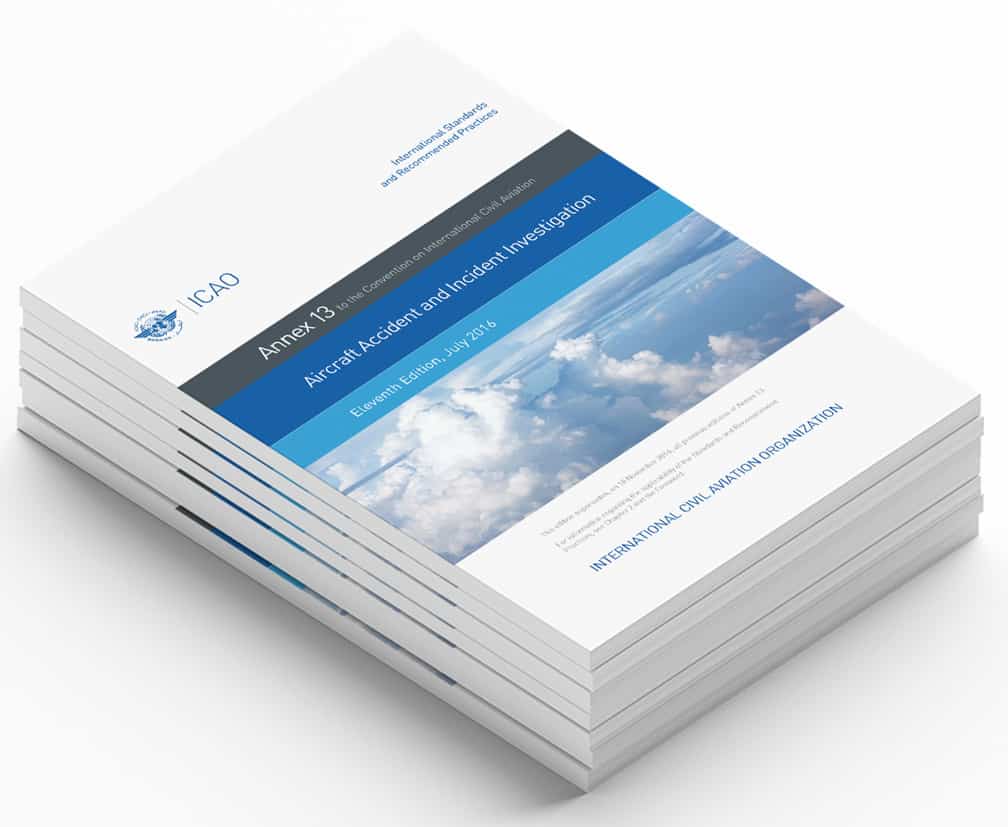To help the public and media better understand the scope and substance of ICAO’s involvement in international aircraft accident investigations, we are providing answers to some frequently asked questions below. ICAO does not normally participate in aircraft accident investigations, except when the State or States with due authority under Annex 13— Aircraft Accident and Incident Investigation request our assistance directly. In those exceptional circumstances, assistance normally involves ICAO acting as an official observer and/or clarifying various Annex 13 requirements when requested.
 Annex 13 outlines how accident investigation participating States are determined, as well as the process leading to the issuance of an accident investigation Preliminary Report (within 30 days of the event) and Final Report (ASAP or within 12 months of the event) following completion of the investigation. Final Reports ultimately provide as much official information as possible on an accident investigation’s findings, causes and/or contributing factors, as well as any safety recommendations on how applicable aviation safety frameworks should be amended in the future.
Annex 13 outlines how accident investigation participating States are determined, as well as the process leading to the issuance of an accident investigation Preliminary Report (within 30 days of the event) and Final Report (ASAP or within 12 months of the event) following completion of the investigation. Final Reports ultimately provide as much official information as possible on an accident investigation’s findings, causes and/or contributing factors, as well as any safety recommendations on how applicable aviation safety frameworks should be amended in the future.
We are sharing Annex 13 in its entirety below. Links to view the publication in ICAO’s six official languages are also provided.
What is the international definition of an aircraft accident?
Annex 13 to the Convention on International Civil Aviation, which reflects the Standards and Recommended Practices covering Aircraft Accident and Incident Investigation, defines an accident as an occurrence associated with the operation of an aircraft: – in which a person is fatally or seriously injured; – in which an aircraft sustains damage or structural failure requiring repair; – after which the aircraft in question is classified as being missing.
Which State or States are responsible for conducting an accident investigation, and what other States may participate?
Annex 13 stipulates that the State of Occurrence shall institute an investigation into the circumstances of the accident and be responsible for the conduct of the investigation. The State of Occurrence may also delegate all or part of the investigation’s responsibilities to another State, or to a regional accident and incident investigation organization. Besides the State of Occurrence, Annex 13 also identifies the additional States which are entitled to appoint an accredited representative (with or without associated advisers) to take part in an investigation. These include:
- The State of Registry: the State on whose register the aircraft is entered.
- The State of the Operator: the State in which the operator’s principal place of business is located or, if there is no such place of business, the operator’s permanent residence.
- The State of Design: The State having jurisdiction over the company responsible for the aircraft type design.
- The State of Manufacture: The State having jurisdiction over the company responsible for the final assembly of the aircraft.
Additionally, a State which has a special interest in an accident, for example by virtue of the number of its citizens involved in or impacted by it, is also entitled to appoint an expert to the accident investigation. These special interest State experts are entitled to:
- visit the scene of the accident;
- have access to the factual information released by the State in charge;
- receive a copy of the accident investigation Final Report.
What is the primary objective of an Annex 13 investigation?
The sole objective of an Annex 13 investigation is to generate safety data and information to aid with the prevention of future and similar accidents or incidents. Annex 13 investigations do not concern themselves in any way with the apportioning of blame or liability.
How are Annex 13 accident investigations reported?
According to Annex 13, which is shared in full below, the State conducting the investigation of an accident or incident is expected to produce a Preliminary Report within 30 days of the accident. This Preliminary Report may be public or confidential at the discretion of the State in charge. A publicly available Final Report is encouraged to be produced by the State in charge of the investigation within 12 months of the accident.
Annex 13 is also available in the following languages:

